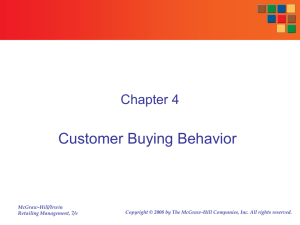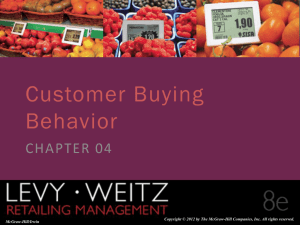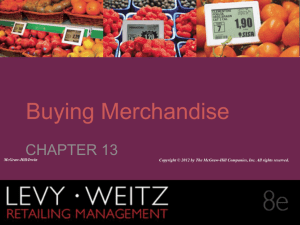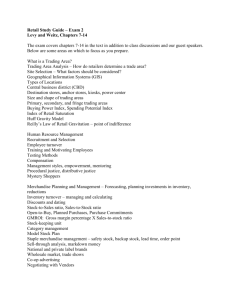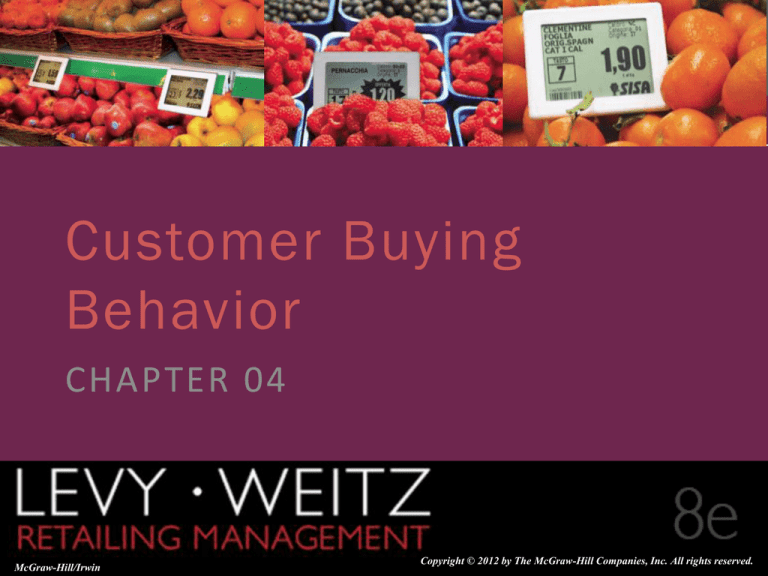
CHAPTER 4
2
1
Customer Buying
Behavior
CHAPTER 04
Retailing
Management 8e
McGraw-Hill/Irwin
4-1
Copyright
© 2012 by The McGraw-Hill Companies, Inc. All rights reserved.
© The McGraw-Hill Companies, All
rights reserved.
The World of Retailing
CHAPTER 4
2
1
Introduction to the World of Retailing
Types of Retailers
Multichannel Retailing
Customer Buying Behavior
4-2
Questions
CHAPTER 4
2
1
• How do customers decide which retailer to go to and
what merchandise to buy?
• What social and personal factors affect customer
purchase decisions?
• How can retailers get customers to visit their stores
more frequently, and buy more merchandise during
each visit?
• Why and how do retailers group customers into market
segments?
4-3
Illustration of Buying Process
CHAPTER 4
2
1
• Eva Carlyn, a student at the University of Washington, is
beginning to interview for jobs.
• For the first interviews on campus,
Eva planned to wear the blue suit
her parents bought her
three years ago.
• But after looking at her suit, she
realizes that it’s not stylish, and
it shows signs of wear.
• She wants to make a strong first impression during her interviews,
so she decides to buy a new suit.
© Digital Vision
4-4
Illustration (Continued)
CHAPTER 4
2
1
• Eva surfs the Internet for tips on dressing for interviews
(http://www.collegegrad.com and
http://www.jobsearch.about.com) and looks through catalogs to
see which styles are offered. However, she decides to go to retail
store to try things on, and to have the suit in time for her first
interview next week.
• She usually shops at Abercrombie & Fitch and American Eagle
Outfitter, but neither sells business suits. Before going to the mall,
she goes to http://www.brandhabit.com, a site that enables her
to examine and compare the suits currently available at the mall.
• Armed with a list of possibilities, she goes directly to the stores
that she reviewed on http://www.BrandHabit.com.
4-5
Illustration (Continued)
CHAPTER 4
2
1
• She likes to shop with
Britt, but Britt is in
Paris for the semester.
• Since she values Britt’s
opinion, Eva shares her
shopping list with Britt
on
http://www.kaboodle.
com.
© Ingram Publishing/AGE Fotostock
4-6
Illustration (Continued)
CHAPTER 4
2
1
• Eva wanders into Macy’s, as a salesperson approaches her in the
career women’s department.
• After asking her what type of suit she wants and her size, the
salesperson shows her three suits. Eva photographs them with
her cell phone, and text messages them to Britt in Paris.
• Britt likes all three, so Eva tries
them on again. However, after
messaging Britt more photos,
all three individuals decide the
2nd suit is the most appropriate
for the interview.
© Bananastock/Punchstock
4-7
Illustration (Continued)
CHAPTER 4
2
1
• Eva is happy with the aesthetics of the suit:
its color, fit, fabric, and length. Although, she
is about the costs of dry cleaning, and she
realizes she’s spending more money than
she had planned.
• Then Eva decides to buy it after another
customer in the store tells her she
appears very professional in the suit
• As the salesperson walks with Eva to the cash register, they pass a
display of scarves. The salesperson stops, picks up a scarf, and
demonstrates to her how well the scarf complements the suit. As
a result, Eva also decides to buy the scarf.
4-8
Stages in the Buying Process
CHAPTER 4
2
1
4-9
Types of Needs
CHAPTER 4
2
1
• Utilitarian Needs –satisfied
when purchases accomplish a
specific task. Shopping needs
to be easy, and effortless like
Sam’s or a grocery store.
• Hedonic needs – satisfied
when purchases accomplish a
need for entertainment,
emotional, and recreational
experience as in department
stores or specialty stores.
4-10
Hedonic Needs that Retailers can Satisfy
CHAPTER 4
2
1
• Stimulation
• Ex: Background music,
visual displays, scents
• Satisfy need for power
and status
• Ex: Canyon Ranch –
upscale health resorts
• Adventure
• Treasure hunting for
bargains
4-11
Conflicting Needs
CHAPTER 4
2
1
• Ex: Eva’s hedonic needs (wearing a DKNY suit to
enhance self-image) conflict with her budget, and her
utilitarian need to get a job.
• Customers make trade-offs between their conflicting
needs
• Cross-shopping
4-12
Information Search
CHAPTER 4
2
1
• Amount of Information Search Depends on the value from
searching versus the cost of searching
• Factors Affecting Amount of Information Search
• Product Characteristics
• Complexity
• Cost
• Customer Characteristics
• Past experience
• Perceived risk
• Time pressure
• Market Characteristics
• Number of alternative brands
4-13
Sources of Information
• Internal
• Past experiences
• Memory
• External
• Consumer reports
• Advertising
• Word of mouth
CHAPTER 4
2
1
Digital Vision / Getty Images
© Dynamic Graphics/Picture Quest
4-14
How Can Retailers Limit
the Information Search?
CHAPTER 4
2
1
• Information from sales associates
• Provide an assortment of services
• Provide good assortments
• Everyday low pricing
• Credit
Royalty-Free/CORBIS
4-15
Internet, Information Search,
and Price Competition
CHAPTER 4
2
1
• Profound impact on consumers’ ability to gather
external information
• Number of stores visited is no longer limited by physical
distance
• Information about the quality and performance at a low
search cost
• Retailers using an Internet channel can differentiate
their offerings by providing better services and
information
4-16
Evaluation of Alternatives
CHAPTER 4
2
1
• Multiattribute attitude model:
• Customers see a retailer, product, or service as a
collection of attributes or characteristics
• Predict a customer’s evaluation of a retailer, product,
or service based on
• Its performance on relevant attributes
• the importance of those attributes to the customer
4-17
Information about
Retailers Selling Groceries
CHAPTER 4
2
1
4-18
Information Used
in Evaluating Retailers
CHAPTER 4
2
1
4-19
Information Needed to
Use Multi-Attribute Model
CHAPTER 4
2
1
• Alternative Consumer Considering
• Characteristic/Benefits Sought in Making Store and
Merchandise Choices
• Ratings of Alternative Performance on Criteria
• Importance of Criteria to Consumer
4-20
Getting into the Consideration Set
CHAPTER 4
2
1
• Consideration set: the set
of alternatives the
customer evaluates when
making a selection
• Retailers develop
programs influencing topof-mind awareness
• Get exposure on search
engines like Google
• Try to be the top of the page
• More stores in the same area
(e.g., Starbucks)
4-21
Methods for increasing the chance of store visit after
getting into the consideration set
CHAPTER 4
2
1
• Increase Performance Beliefs of Your Store
• Decrease Performance Beliefs About Competitor
• Increase Importance Weight of Attributes on which You
Have an Advantage
• Add a New Benefit on which You Excel
4-22
Purchasing Merchandise or Services
CHAPTER 4
2
1
Customers do not always purchase a brand with the
highest overall evaluation.
The McGraw-Hill Companies, Inc./Jill Braaten, photographer
• The high-rated item may not be
available in the store.
• How can a retailer increase the
chances that customers will
convert their merchandise
evaluations into purchases?
4-23
Postpurchase Evaluation
CHAPTER 4
2
1
• Satisfaction
• A post-consumption evaluation of how well a store or
product meets or exceeds customer expectations
• Becomes part of the customer’s internal information
that affects future store and product decisions
• Builds store and brand loyalty
4-24
Types of Buying Decisions
CHAPTER 4
2
1
• Extended Problem Solving
• High financial or Social Risk
• Limited Problem Solving
• Some Prior Buying Experience
• Habitual Decision Making
• Store Brand, Loyalty
4-25
Extended Problem Solving
CHAPTER 4
2
1
Consumers devote time and effort analyzing alternatives
• Financial risks – purchasing
expensive products or
services
• Physical risks – purchases
that will affect consumer’s
health and safety
• Social risks – consumers will
believe product will affect
how others view them
4-26
What do Retailers Need to do for Customers
Engaged in Extended Problem Solving
CHAPTER 4
2
1
• Provide a Lot of
Information
• Use Salespeople rather
than advertising to
• Communicate
with customers
• Reduce the Risks
• Offer Guarantees
• Return Privileges
© Royalty-Free/CORBIS
4-27
Limited Problem Solving
CHAPTER 4
2
1
Purchase decisions process involving moderate
amount of effort and time
• Customers engage in this
when they have had prior
experience with products
or services
• Customers rely more upon
personal knowledge
• Majority of customer
decisions involve limited
problem solving
(c) Brand X Pictures/PunchStock
4-28
What do Retailers Need to do for Customers
Engaged in Limited Problem Solving?
CHAPTER 4
2
1
• It depends…
• If the Customer Is Coming to You, Provide a Positive
Experience and Create Loyalty
• Make Sure Customer is Satisfied
• Provide Good Service, Assortments, value
• Offer Rewards to Convert to Loyal Customer
• If the Customer Goes to Your Competitor’s Store, Change
Behavior
• Offer More Convenient Locations, Better Service and
Assortments
4-29
Encouraging Impulse Buying
CHAPTER 4
2
1
• Impulse buying: one common type
of limited problem solving
• Influence by using prominent pointof- purchase (POP) or point-of-sale
(POS)
PhotoLink/Getty Images
• Have Salespeople Suggest Add-ons
• Have Complementary Merchandise
Displayed Near Product of Interest
• Use Signage in Aisle or Special Displays
• Put Merchandise Where Customers Are
Waiting
4-30
Habitual Problem Solving
CHAPTER 4
2
1
Purchase decision process involving little or no conscious effort
• For purchases that aren’t
important to the
consumer
• For merchandise
consumers have
purchased in the past
• For consumers loyal to
brands or a store
4-31
Customer Loyalty
CHAPTER 4
2
1
• Brand Loyalty
• Committed to a Specific
Brand
• Reluctant to Switch to a
Different Brand
• May Switch Retailers to Buy
Brand
• Store Loyalty
• Committed to a Specific
Retailer
• Reluctant to Switch Retailers
4-32
What do Retailers Need to do for Customers
Engage in Habitual Decision Making
CHAPTER 4
2
1
• It depends…
• If the customer habitually comes to you, reinforce
behavior
• Make sure merchandise in stock
• Provide good service
• Offer rewards to loyal customer
• If the customer goes to your competitor’s store, break
the habit
• Offer special promotions
4-33
Social Factors
Influencing the Buying Decision Process
CHAPTER 4
2
1
4-34
Family Influences Buying Decisions
CHAPTER 4
2
1
• Purchases are for entire
family to use
• Whole family participates in
decision making process
• Retailers work to satisfy
needs of all family members
Kids in the U.S. spend over $200 billion on personal items. They directly influence
the purchase of another $300 billion worth of items such as food and clothing.
4-35
Reference Groups
CHAPTER 4
2
1
• Reference groups affect buying
decisions by:
• Offering information
• Providing rewards for specific
purchasing behaviors
• Enhancing a consumer’s self-image
(c) image100/PunchStock
• A reference group is one or more
people whom a person uses as a basis
of comparison for beliefs, feelings and
behaviors.
4-36
Reference Groups
CHAPTER 4
2
1
• Eva…. looks to
• Soccer player Mia Hamm and tennis player Maria
Sharapova for the selection of athletic wear
• Jessica Simpson for casual fashion advice
• Store advocates:
• Customers that like a store so much that they actively
share their positive experiences with friends and family
• Victoria Secret
• Alpha Moms
4-37
Culture
CHAPTER 4
2
1
• Culture is the meaning,
beliefs, morals and
values shared by most
members of a society
• Western culture:
individualism
• Eastern culture:
collectivism
• Subcultures are distinctive
groups of people within a
culture
4-38
Criteria for Evaluating Market Segments
CHAPTER 4
2
1
Actionable
• Retailer should know what to do to
satisfy needs for the customers are
in the segment
Identifiable
• Retailer is able to determine
which customers are in the
segment
4-39
Criteria for Evaluating Market Segments
CHAPTER 4
2
1
Substantial
• Market segment must be larger
enough or its buying power
significant to generate sufficient
profits
Reachable
• Retailer can target promotions and
other elements of the retail mix to
customers in the segment
4-40
Approaches for Segmenting Markets
CHAPTER 4
2
1
4-41
Approaches for Segmenting Markets
CHAPTER 4
2
1
• Geographic segmentation groups customers according
to where they live.
• Demographic segmentation groups consumers on the
basis of easily measured, objective characteristics such
as age, gender, income, and education.
4-42
Approaches for Segmenting Markets
CHAPTER 4
2
1
• Geodemographic segmentation uses both geographic
and demographic characteristics to classify consumers.
• Lifestyle, or psychographics , refers to how people live,
how they spend their time and money, what activities
they pursue, and their attitudes and opinions about the
world in which they live.
4-43
Approaches for Segmenting Markets
CHAPTER 4
2
1
• Buying situations can influence customers with the
same demographics or lifestyle.
• Benefit segmentation groups customers seeking similar
benefits.
4-44
Keywords
CHAPTER 4
2
1
• complexity The ease with which consumers can understand and use a new fashion.
• cross-shopping A pattern of buying both premium and low-priced merchandise or patronizing expensive, statusoriented retailers and price-oriented retailers.
• everyday low pricing (EDLP) A pricing strategy that stresses continuity of retail prices at a level somewhere
between the regular nonsale price and the deep-discount sale price of the retailer’s competitors.
• impulse buying A buying decision made by customers on the spot after seeing the merchandise.
• information search The stage in the buying process in which a customer seeks additional information to satisfy a
need.
• lifestyle Refers to how people live, how they spend their time and money, what activities they pursue, and their
attitudes and opinions about the world they live in.
• multiattribute attitude model A model of customer decision making based on the notion that customers see a
retailer or a product as a collection of attributes or characteristics. The model can also be used for evaluating a
retailer, product, or vendor. The model uses a weighted average score based on the importance of various issues
and performance on those issues.
• postpurchase evaluation The evaluation of merchandise or services after the customer has purchased and
consumed them.
• satisfaction A post-consumption evaluation of the degree to which a store or product meets or exceeds
customer expectations.
• store advocates Customers who like a store so much that they actively share their positive experiences with
friends and family.
4-45


